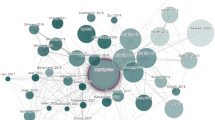Abstract
In this paper, we provide a novel interpretation of a global optimization procedure forstandard quadratic problems (QPs) in terms of selection models. A standard QP consists ofmaximizing a quadratic form over the standard simplex. Recently, local solutions to standardQPs have been obtained with the help of replicator dynamics, which were designed to modelevolutionary processes. Following trajectories under these dynamics, one obtains a sequenceof feasible points with strictly increasing objective values, which approach stationary points.We present regularity conditions which ensure that the limiting points are indeed localsolutions, so that jamming could be avoided. Genetic engineering via negative fitness is ablock pivoting procedure which either delivers a certificate for global optimality of thecurrent local solution, or else enables an escape from its basin of attraction, if it is inefficient.The name originates from the way the block pivot is obtained: via minimization (rather thanmaximization) of a subproblem. We also elaborate on an important application, the searchfor a maximum clique in an undirected graph, and report both theoretical and empiricalresults.
Similar content being viewed by others
References
L.E. Baum and J.A. Eagon, An inequality with applications to statistical estimation for probabilistic functions of Markov processes and to a model for ecology, Bull. Amer. Math. Soc. 73(1967)360-363
L.E. Baum and G.R. Sell, Growth transformations for functions on manifolds, Pacif. J. Math. 27(1968)211-227.
I.M. Bomze, Lotka-Volterra equation and replicator dynamics: A two-dimensional classification, Biol. Cybern. 48(1983)201-211.
I.M. Bomze, Non-cooperative two-person games in biology: A classification, Int. J. Game Theory 15(1986)31-57.
I.M. Bomze, Evolution towards the maximum clique, J. Global Optimiz. 10(1997)143-164.
I.M. Bomze, Global escape strategies for maximizing quadratic forms over a simplex, J. Global Optimiz. 11(1997)325-338.
I.M. Bomze, On standard quadratic optimization problems, J. Global Optimiz. 13(1998)369-387.
I.M. Bomze, M. Budinich, P.M. Pardalos and M. Pelillo, The maximum clique problem, to appear in: Handbook of Combinatorial Optimization, eds. D.Z. Du and P.M. Pardalos, Kluwer, Dordrecht, 1999.
I.M. Bomze, M. Pelillo and R. Giacomini, Evolutionary approach to the maximum clique problem: Empirical evidence on a larger scale, in: Developments in Global Optimization, eds. I.M. Bomze, T. Csendes, R. Horst and P.M. Pardalos, Kluwer, Dordrecht, 1997, pp. 95-108.
I.M. Bomze and F. Rendl, Replicator dynamics for the evolution towards the maximum clique: Variations and experiments, in: High Performance Algorithms and Software in Nonlinear Optimization, eds. R. DeLeone, A. Murli, P.M. Pardalos and G. Toraldo, Kluwer, Dordrecht, 1998, pp. 53-67
A. Cabrales and J. Sobel, On the limit points of discrete selection dynamics, J. Econ. Theory 57(1992)473-504.
J.F. Crow and M. Kimura, An Introduction to Population Genetics Theory, Harper and Row, New York, 1970.
R.A. Fisher, The Genetical Theory of Natural Selection, Clarendon Press, Oxford, 1930.
L.E. Gibbons, D.W. Hearn, P.M. Pardalos and M.V. Ramana, Continuous characterizations of the maximum clique problem, Math. Oper. Res. 22(1997)754-768.
J. Hofbauer and K. Sigmund, The Theory of Evolution and Dynamical Systems, Cambridge University Press, 1988.
R. Horst, P.M. Pardalos and N.V. Thoai, Introduction to Global Optimization, Kluwer, Dordrecht, 1995.
R.A. Hummel and S.W. Zucker, On the foundations of relaxation labeling processes, IEEE Trans. Pattern Anal. Machine Intell. 5(1983)267-287.
A. Kelley, The stable, center-stable, center, center-unstable, unstable manifolds, J. Differential Equations 3(1967)546-570.
A. Kelley, Stability of the center-stable manifold, J. Math. Anal. Appl. 18(1967)336-344.
M. Kimura, On the change of population fitness by natural selection, Heredity 12(1958)145-167.
S.E. Levinson, L.R. Rabiner and M.M. Sondhi, An introduction to the application of the theory of probabilistic functions of a Markov process to automatic speech recognition, Bell Syst. Tech. J. 62(1983)1035-1074.
V. Losert and E. Akin, Dynamics of games and genes: Discrete versus continuous time, J. Math. Biol. 17(1983)241-251.
Y. Lyubich, G.D. Maistrowskii and Y.G. Ol'khovskii, Selection-induced convergence to equilibrium in a single-locus autosomal population, Problems of Information Transmission 16(1980)66-75.
D.A. Miller and S.W. Zucker, Copositive-plus Lemke algorithm solves polymatrix games, Oper. Res. Lett. 10(1991)285-290.
T.S. Motzkin and E.G. Straus, Maxima for graphs and a new proof of a theorem of Turán, Can. J. Math. 17/1865)533-540.
K.G. Murty and S.N. Kabadi, Some NP-complete problems in quadratic and linear programming, Math. Progr. 39(1987)117-129.
M. Pelillo, On the dynamics of relaxation labeling processes, Proceedings of the IEEE International Conference on Neural Networks, Orlando, FL, 1994, pp. 1006-1011.
M. Pelillo and A. Jagota, Feasible and infeasible maxima in a quadratic program for maximum clique, J. Artif. Neural Networks 2(1995)411-420.
R. Pemantle, Nonconvergence to unstable points in urn models and stochastic approximations, Ann. Prob. 18(1990)698-712.
A. Rosenfeld, R.A. Hummel and S.W. Zucker, Scene labeling by relaxation operations, IEEE Trans. Syst., Man, Cybern. 6(1976)420-433.
R. Sedgewick, Algorithms in C++, Addison-Wesley, New York, 1992.
K. Sigmund, Game dynamics, mixed strategies, and gradient systems, Theor. Pop. Biol. 32(1987)114-126.
V. Stix, The maximum clique problem — a fresh approach: Empirical evidence and implementation in C++, Thesis, University of Vienna, 1997, also available as I.S.O.C. Technical Report TR-97-05.
P. Taylor and L. Jonker, Evolutionarily stable strategies and game dynamics, Math. Biosci. 40(1978)145-156.
Rights and permissions
About this article
Cite this article
Bomze, I., Stix, V. Genetic engineering via negative fitness:Evolutionary dynamics for global optimization. Annals of Operations Research 89, 297–318 (1999). https://doi.org/10.1023/A:1018935925761
Issue Date:
DOI: https://doi.org/10.1023/A:1018935925761




